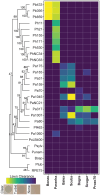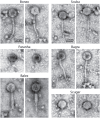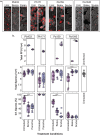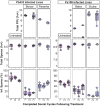Tracking tripartite interaction dynamics: isolation, integration, and influence of bacteriophages in the Paraburkholderia-Dictyostelium discoideum symbiosis system
- PMID: 40384784
- PMCID: PMC12081417
- DOI: 10.3389/fmicb.2025.1537073
Tracking tripartite interaction dynamics: isolation, integration, and influence of bacteriophages in the Paraburkholderia-Dictyostelium discoideum symbiosis system
Abstract
Introduction: Bacteriophages influence interactions between bacterial symbionts and their hosts by exerting parasitic pressure on symbiont populations and facilitating bacterial evolution through selection, gene exchange, and prophage integration. Host organisms also modulate phage-bacteria interactions, with host-specific contexts potentially limiting or promoting phage access to bacterial symbionts or driving alternative phenotypic or evolutionary outcomes.
Methods: To better elucidate tripartite phage-bacteria-host interactions in real-time, we expanded the Dictyostelium discoideum-Paraburkholderia symbiosis system to include Paraburkholderia-specific phages. We isolated six environmental Paraburkholderia phages from soil samples using a multi-host enrichment approach. We also identified a functional prophage from monocultures of one of the Paraburkholderia symbiont strains implemented in the enrichment approach. These phages were evaluated across all three amoeba-associated Paraburkholderia symbiont species. Finally, we treated Paraburkholderia infected amoeba lines with select phage isolates and assessed their effects on symbiont prevalence and host fitness.
Results: The isolated phages exhibited diverse plaquing characteristics and virion morphologies, collectively targeting Paraburkholderia strains belonging to each of the amoeba-symbiotic species. Following amoeba treatment experiments, we observed that phage application in some cases reduced symbiont infection prevalence and alleviated host fitness impacts, while in others, no significant effects were noted. Notably, phages were able to persist within the symbiont-infected amoeba populations over multiple culture transfers, indicating potential long-term interactions.
Discussion: These findings highlight the variability of phage-symbiont interactions within a host environment and underscore the complex nature of phage treatment outcomes. The observed variability lays the foundation for future studies exploring the long-term dynamics of tripartite systems, suggesting potential mechanisms that may shape differential phage treatment outcomes and presenting valuable avenues for future investigation.
Keywords: Dictyostelium discoideum; Paraburkholderia; amoeba; bacteriophage; symbiosis.
Copyright © 2025 DiSalvo, Maness, Braun, Tran and Hofferkamp.
Conflict of interest statement
The authors declare that the research was conducted in the absence of any commercial or financial relationships that could be construed as a potential conflict of interest.
Figures







Similar articles
-
Complexities of Inferring Symbiont Function: Paraburkholderia Symbiont Dynamics in Social Amoeba Populations and Their Impacts on the Amoeba Microbiota.Appl Environ Microbiol. 2022 Sep 22;88(18):e0128522. doi: 10.1128/aem.01285-22. Epub 2022 Aug 31. Appl Environ Microbiol. 2022. PMID: 36043858 Free PMC article.
-
Reduced and Nonreduced Genomes in Paraburkholderia Symbionts of Social Amoebas.mSystems. 2022 Oct 26;7(5):e0056222. doi: 10.1128/msystems.00562-22. Epub 2022 Sep 13. mSystems. 2022. PMID: 36098425 Free PMC article.
-
Paraburkholderia Symbionts Display Variable Infection Patterns That Are Not Predictive of Amoeba Host Outcomes.Genes (Basel). 2020 Jun 20;11(6):674. doi: 10.3390/genes11060674. Genes (Basel). 2020. PMID: 32575747 Free PMC article.
-
A niche perspective on the range expansion of symbionts.Biol Rev Camb Philos Soc. 2020 Apr;95(2):491-516. doi: 10.1111/brv.12574. Epub 2019 Dec 5. Biol Rev Camb Philos Soc. 2020. PMID: 31808246 Review.
-
The role of defensive symbionts in host-parasite coevolution.Biol Rev Camb Philos Soc. 2018 Nov;93(4):1747-1764. doi: 10.1111/brv.12417. Epub 2018 Apr 16. Biol Rev Camb Philos Soc. 2018. PMID: 29663622 Review.
References
LinkOut - more resources
Full Text Sources

